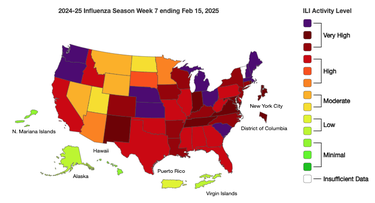The peak for flu may have passed but COVID cases are still on the rise
Cases of COVID-19 have been steadily increasing in New York state since mid-November while influenza has been characterized as “widespread” by the state’s health department for 10 weeks running.
While a map from the Centers for Disease Control and Prevention shows a “very high” activity level for flu in New York, graphs from the state’s health department show both hospitalization and cases of flu statewide peaking in early February and now in decline.
The state’s health department reports that last week, 54 percent of the nearly 78,000 specimens for influenza were positive, a decrease of 15 percent from the week before.
Similarly, there was an 18 percent decrease in hospitalizations.
The peak came several weeks later than in recent years.
There were 42 outbreaks reported in hospitals and 44 outbreaks reported in nursing homes this past week, a 3 percent decrease in hospital and nursing home outbreaks compared with the previous week.
So far this flu season, a total of 708 outbreaks have been reported from hospitals and nursing homes statewide.
There was one influenza-associated pediatric death reported this past week with 13 reported this flu season.
Meanwhile, the state health department charts COVID-19 peaking in July and then steadily decreasing until mid-November when it began to rise again.
The current dominant variant, at 51.4 percent, is BA.4.
A year ago, the CDC updated its guidelines — the first revision in COVID-19 guidelines since 2021 — to target respiratory viruses more broadly and be easier for the public to follow.
The “core strategy” outlined by the CDC is to “stay home and away from others (including people you live with who are not sick) if you have respiratory virus symptoms that aren’t better explained by another cause.”
People can return to normal activities when, for 24 hours, symptoms are getting better and they have not had a fever.
“When you go back to your normal activities,” the CDC says, “take added precaution over the next 5 days, such as taking additional steps for cleaner air, hygiene, masks, physical distancing, and/or testing when you will be around other people indoors.”
People with symptoms should test for COVID-19, the recent release from the governor’s office said, adding, “Those who test positive should contact their health care provider about possible treatments, which have been shown to be effective at reducing the chances of serious outcomes.”
Elderly people and those who are immunocompromised, have lung or cardiovascular conditions, or other risk factors “are especially encouraged to discuss COVID-19 treatments with a health care professional.”
“Because SARS-CoV-2 circulates year-round and immunity from vaccination wanes,” the CDC continues to recommend a second 2024–2025 COVID-19 vaccine dose for all adults aged 65 and older and for persons aged 6 months to 64 years with moderate or severe immunocompromise, 6 months after their last dose of 2024–2025 COVID-19.

